Self-seeded City
This is an Ailanthus (Heaven Tree, Tree-of-Heaven, Ailanthus altissima) seedling that has grown up in an unused tree pit along Dundas Street West in the Junction. In a city that has trouble getting healthy, nursery-grown trees to survive in the harsh conditions of the tree pit, there’s some irony to a tree naturally growing up in one from seed, and looking so happy to boot.
Unfortunately, there are few, if any, native species in Toronto, that can grow so happily in such conditions. The Ailanthus is, of course, not one of them, being native to China. It is also notoriously fast-growing, is naturalized in Toronto and much of the United States, is a prodigious seed-producer, and is very difficult to kill. In many places, it is also a voracious competitor against native species for light and resources, and due to its rate of growth and seed production, it usually wins. Combined with its production of a toxin that inhibits the development of other species, it is considered to be invasive and an ecological threat.
You will find the Ailanthus in laneways, abandoned and vacant sites, and along fencelines. There are few deliberately-planted examples in Toronto, one beautiful specimen on the University of Toronto’s downtown campus at Hart House Circle comes to mind. The tree in the 1943 novel (and film) A Tree Grows in Brooklyn by Betty Smith is an Ailanthus, allegorically referencing the species’ unstoppable ability to strive and survive even in the worst conditions. I once saw one growing out from behind a 2.5m wall that was only about 30cm from the building behind it.
I once harboured an idea that we could significantly green-up a city like Toronto (with difficult tree-growing conditions and little will to seriously tackle the street tree problem) by attempting to take advantage of some of the “weed” tree species by helping them to locate where we want them – imagine a beautiful, tree-lined laneway! Normally, we consider that there’s simply not enough room to grow trees there, but there are many examples of large Ailanthus, Elm (usually Ulmus glabra, or U. pumila), and Manitoba Maple (Acer negundo), vigorously growing along laneways.
The problem with this plan of course, is that all of these species are non-native, naturalized and invasive, and thus pose a particular threat to local natural vegetative communities in places like ravines and woodlots through their seed production. Whether it’s worth pursuing sterile cultivars or clones for the purposes of greening up the city is a bit questionable, and it would be almost delicious irony if the naturalized species itself seeded into the planting locations and out-competed our carefully selected non-seed producing (and genetically stagnant) tree.
However, since it doesn’t seem all that likely that we’ll ever get rid of these “unwanted” opportunists, maybe just leaving a cutout every 10 metres or so in the concrete of laneways would be enough of an invitation? After all, if you can’t beat ’em, use ’em.


1 Comment so far
Leave a comment
i agree we use the trees
By Steve & Cloie Labriola on 04.27.13 7:31 pm
Leave a comment
Line and paragraph breaks automatic, e-mail address never displayed, HTML allowed:
<a href="" title=""> <abbr title=""> <acronym title=""> <b> <blockquote cite=""> <cite> <code> <del datetime=""> <em> <i> <q cite=""> <s> <strike> <strong>